介词 关系代词
定语从句 知识讲解 “介词+关系代词”的用法
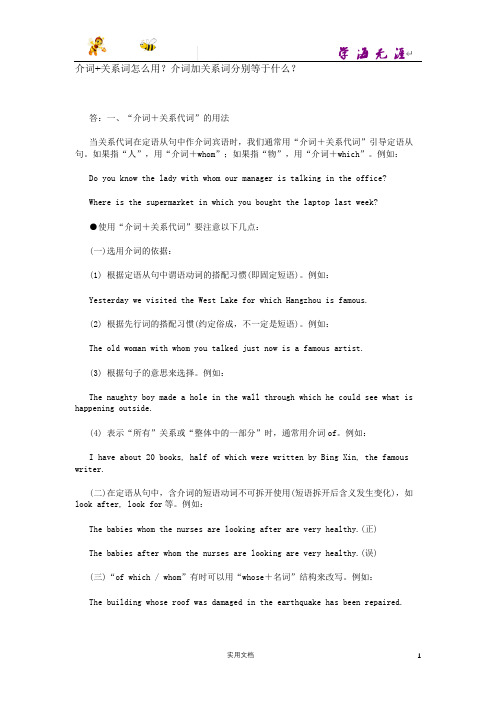
介词+关系词怎么用?介词加关系词分别等于什么?答:一、“介词+关系代词”的用法当关系代词在定语从句中作介词宾语时,我们通常用“介词+关系代词”引导定语从句。
如果指“人”,用“介词+whom”;如果指“物”,用“介词+which”。
例如:Do you know the lady with whom our manager is talking in the office?Where is the supermarket in which you bought the laptop last week?●使用“介词+关系代词”要注意以下几点:(一)选用介词的依据:(1) 根据定语从句中谓语动词的搭配习惯(即固定短语)。
例如:Yesterday we visited the West Lake for which Hangzhou is famous.(2) 根据先行词的搭配习惯(约定俗成,不一定是短语)。
例如:The old woman with whom you talked just now is a famous artist.(3) 根据句子的意思来选择。
例如:The naughty boy made a hole in the wall through which he could see what is happening outside.(4) 表示“所有”关系或“整体中的一部分”时,通常用介词of。
例如:I have about 20 books, half of which were written by Bing Xin, the famous writer.(二)在定语从句中,含介词的短语动词不可拆开使用(短语拆开后含义发生变化),如look after, look for等。
例如:The babies whom the nurses are looking after are very healthy.(正)The babies after whom the nurses are looking are very healthy.(误)(三)“of which / whom”有时可以用“whose+名词”结构来改写。
“介词+关系代词”引导的定语从句_
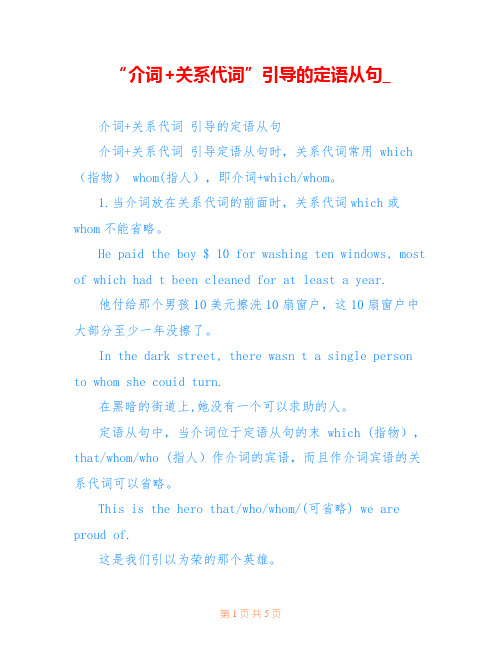
“介词+关系代词”引导的定语从句_介词+关系代词引导的定语从句介词+关系代词引导定语从句时,关系代词常用 which (指物) whom(指人),即介词+which/whom。
1.当介词放在关系代词的前面时,关系代词which或whom不能省略。
He paid the boy $ 10 for washing ten windows, most of which had t been cleaned for at least a year.他付给那个男孩10美元擦洗10扇窗户,这10扇窗户中大部分至少一年没擦了。
In the dark street, there wasn t a single person to whom she couid turn.在黑暗的街道上,她没有一个可以求助的人。
定语从句中,当介词位于定语从句的末 which (指物),that/whom/who (指人)作介词的宾语,而且作介词宾语的关系代词可以省略。
This is the hero that/who/whom/(可省略) we are proud of.这是我们引以为荣的那个英雄。
This is the pen that/which/(可省略) I I wrote the letter with.这是我写信时用的那支钢笔。
【温馨提示】①有些动词+介词的固定词组不可把介词置于关系代词前。
这就是我正在找的磁带。
[误]This is the right tape for which I m looking, [正]This is the right tape that I m looking for.②常见的不可拆开的动词词组有:care for 喜欢,关心deal with 处理,对付get through 通过;到达;接通电话hear from/of 收到某人的来信/听说look for/after寻找/照顾send for派人去请see to照管,料理3.复合介词短语+关系代词which 引导的定语从句,这种结构引导的定语从句常与先行词用逗号分开,定语从句常用倒装语序。
介词加关系代词例句

介词加关系代词例句摘要:一、介词加关系代词的概述1.介词加关系代词的定义2.介词加关系代词的作用二、介词加关系代词的例句1.常见介词加关系代词的例句2.特殊介词加关系代词的例句三、介词加关系代词在句子中的位置及注意事项1.介词加关系代词在句子中的位置2.使用介词加关系代词的注意事项正文:一、介词加关系代词的概述介词加关系代词是一种用于表示句子中成分之间关系的语法结构。
其中,介词用于表示关系,关系代词用于代替句子中的成分。
这种结构在中文中十分常见,有助于更准确地表达句子中各成分之间的关系。
2.介词加关系代词的作用介词加关系代词的主要作用是明确表示句子中各成分之间的关系,使句子更加通顺、连贯。
通过使用介词加关系代词,我们可以避免句子中出现重复或模糊的表达,从而提高语言表达的准确性和简洁性。
二、介词加关系代词的例句1.常见介词加关系代词的例句例如:“对于这个问题,我认为(对于)学生来说,最重要的是(的)实践。
”在这个例子中,“对于”是介词,表示问题与学生之间的关系;“的”是关系代词,代替后面的“重要性”。
2.特殊介词加关系代词的例句例如:“如果没有老师的帮助,我不会取得今天的成绩。
(没有)老师(的帮助),我(的)成绩(就)不会有这么好。
”在这个例子中,“没有”是介词,表示“取得成绩”与“老师的帮助”之间的关系;“的”是关系代词,分别代替后面的“成绩”和“帮助”。
三、介词加关系代词在句子中的位置及注意事项1.介词加关系代词在句子中的位置介词加关系代词通常位于所修饰成分的前面。
在中文中,介词和关系代词通常放在句首或句中,根据句子的结构和语境进行调整。
2.使用介词加关系代词的注意事项(1)介词和关系代词的选择要根据句子中各成分之间的关系进行调整,避免使用不合适的介词或关系代词,导致句子表达不准确。
(2)在实际应用中,要注意介词和关系代词的搭配,确保句子表达通顺、连贯。
介词加关系代词引导的定语从句
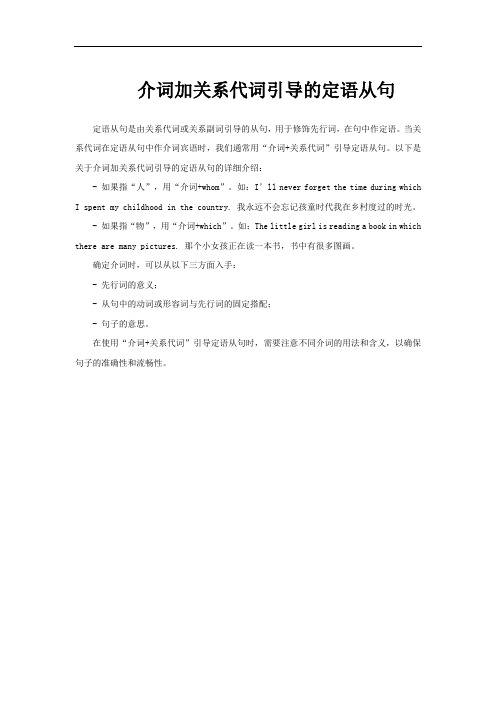
介词加关系代词引导的定语从句
定语从句是由关系代词或关系副词引导的从句,用于修饰先行词,在句中作定语。
当关系代词在定语从句中作介词宾语时,我们通常用“介词+关系代词”引导定语从句。
以下是关于介词加关系代词引导的定语从句的详细介绍:
- 如果指“人”,用“介词+whom”。
如:I’ll never forget the time during which I spent my childhood in the country. 我永远不会忘记孩童时代我在乡村度过的时光。
- 如果指“物”,用“介词+which”。
如:The little girl is reading a book in which there are many pictures. 那个小女孩正在读一本书,书中有很多图画。
确定介词时,可以从以下三方面入手:
- 先行词的意义;
- 从句中的动词或形容词与先行词的固定搭配;
- 句子的意思。
在使用“介词+关系代词”引导定语从句时,需要注意不同介词的用法和含义,以确保句子的准确性和流畅性。
介词和关系代词
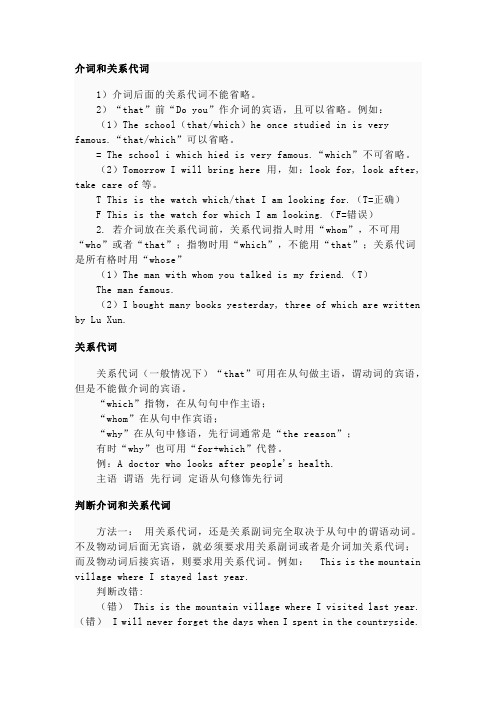
介词和关系代词1)介词后面的关系代词不能省略。
2)“that”前“Do you”作介词的宾语,且可以省略。
例如:(1)The school(that/which)he once studied in is very famous.“that/which”可以省略。
= The school i which hied is very famous.“which”不可省略。
(2)Tomorrow I will bring here 用,如:look for, look after, take care of等。
T This is the watch which/that I am looking for.(T=正确)F This is the watch for which I am looking.(F=错误)2. 若介词放在关系代词前,关系代词指人时用“whom”,不可用“who”或者“that”;指物时用“which”,不能用“that”;关系代词是所有格时用“whose”(1)The man with whom you talked is my friend.(T)The man famous.(2)I bought many books yesterday, three of which are written by Lu Xun.关系代词关系代词(一般情况下)“that”可用在从句做主语,谓动词的宾语,但是不能做介词的宾语。
“which”指物,在从句句中作主语;“whom”在从句中作宾语;“why”在从句中修语,先行词通常是“the reason”;有时“why”也可用“for+which”代替。
例:A doctor who looks after people's health.主语谓语先行词定语从句修饰先行词判断介词和关系代词方法一:用关系代词,还是关系副词完全取决于从句中的谓语动词。
“介词 + 关系代词”一点通
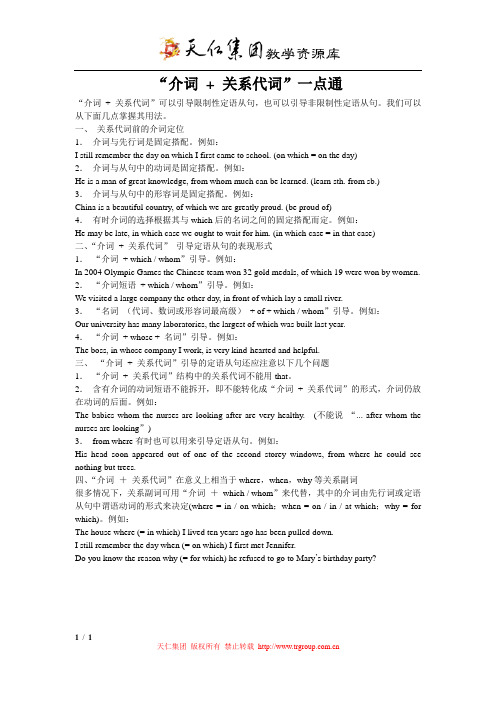
“介词+ 关系代词”一点通“介词+ 关系代词”可以引导限制性定语从句,也可以引导非限制性定语从句。
我们可以从下面几点掌握其用法。
一、关系代词前的介词定位1.介词与先行词是固定搭配。
例如:I still remember the day on which I first came to school. (on which = on the day)2.介词与从句中的动词是固定搭配。
例如:He is a man of great knowledge, from whom much can be learned. (learn sth. from sb.)3.介词与从句中的形容词是固定搭配。
例如:China is a beautiful country, of which we are greatly proud. (be proud of)4.有时介词的选择根据其与which后的名词之间的固定搭配而定。
例如:He may be late, in which case we ought to wait for him. (in which case = in that case)二、“介词+ 关系代词”引导定语从句的表现形式1.“介词+ which / whom”引导。
例如:In 2004 Olympic Games the Chinese team won 32 gold medals, of which 19 were won by women. 2.“介词短语+ which / whom”引导。
例如:We visited a large company the other day, in front of which lay a small river.3.“名词(代词、数词或形容词最高级)+ of + which / whom”引导。
例如:Our university has many laboratories, the largest of which was built last year.4.“介词+ whose + 名词”引导。
英语语法:“介词+关系代词”的用法

英语语法:“介词+关系代词”的用法“介词+关系代词”的用法一、用法说明介词+whom只能指人;介词+ which只能指物。
如:Look, there comes Tom, for whom I have waiting for an hour. 瞧,汤姆来啦,我等他等了一个小时。
Last Saturday evening, I went to Wu Dong’s birthday party, in which I met a foreigner named Jim. 上周星期六的晚上我去参加了吴东的生日聚会,在会上我会到了一个叫吉姆的外国人。
She came into the house, on whose wall there was a portrait of Einstein. 她进入了房间,房子的墙壁上有一张爱因斯坦的画像。
二、注意事项(1) 有时,前面的介词可移到定语从句的中间或后面,此时whom 可用who, that代替;which能够用that代替。
而且who, whom, which, that都可省略。
如:The man with whom you talked just now is our manager. —The man who you talked with just now is our manager. 你刚才与他谈话的那个人就是我们的经理。
He handed me a pen, with which I wrote down my address for him. —He handed me a pen, which I wrote down my address with for him. 他递给我一支钢笔,我就用那支钢笔给他写下了我的地址。
(2) 当先行词是时间、地点、原因从句时,介词+ which一般在定语从句中分别做时间、地点、原因状语,于是介词+ which能够分别用when, where, why代替。
(完整版)介词+关系代词

lived in Tianjin. !
=when
=where
5. Hangzhou is the place to which I went last year.
=when 6. I remember the day on which my father died. I
was only ten years old at that time.
介词+关系词的功能
一、“介词+关系代词” 结构在定语从句中主要起关系副 词的作用,即在定语从句中充当状语。用在介词后的关 系代词只有whom, which和whose 三个,不能用that.
二、介词后面的关系词不能省略。
三、先行词时物时,介词后用关系词which,先行词是人 时,介词后用关系词whom.
2. This is the room in which I lived. =where
3. I don’t know the reason for which he haven’t
come today.
=why
4. Tom still remembers the days during which they
关系副词when, where, why 和介词+which之间的关系
关系副词when, where, why可以用 适当的介词+which来替代。
如:when=in/on/at…+which, where=in/on/at…+which, why=for+which 。
=when 1. I won’t forget the date on which I was born.
定语从句
Preposition +which / +whom
介词加关系代词等于关系副词的例子
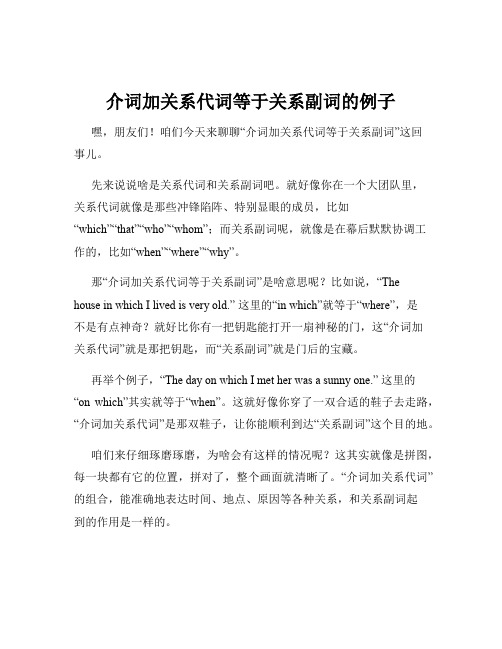
介词加关系代词等于关系副词的例子嘿,朋友们!咱们今天来聊聊“介词加关系代词等于关系副词”这回事儿。
先来说说啥是关系代词和关系副词吧。
就好像你在一个大团队里,关系代词就像是那些冲锋陷阵、特别显眼的成员,比如“which”“that”“who”“whom”;而关系副词呢,就像是在幕后默默协调工作的,比如“when”“where”“why”。
那“介词加关系代词等于关系副词”是啥意思呢?比如说,“The house in which I lived is very old.” 这里的“in which”就等于“where”,是不是有点神奇?就好比你有一把钥匙能打开一扇神秘的门,这“介词加关系代词”就是那把钥匙,而“关系副词”就是门后的宝藏。
再举个例子,“The day on which I met her was a sunny one.” 这里的“on which”其实就等于“when”。
这就好像你穿了一双合适的鞋子去走路,“介词加关系代词”是那双鞋子,让你能顺利到达“关系副词”这个目的地。
咱们来仔细琢磨琢磨,为啥会有这样的情况呢?这其实就像是拼图,每一块都有它的位置,拼对了,整个画面就清晰了。
“介词加关系代词”的组合,能准确地表达时间、地点、原因等各种关系,和关系副词起到的作用是一样的。
比如说,你要描述一个在特定时间发生的事情,用“at the time when”或者“at the time at which”,是不是感觉很啰嗦?直接用“at which”就简洁多啦!想想看,如果没有这种巧妙的组合,我们得费多少口舌才能把意思表达清楚呀!这就像做饭没有调料,总觉得缺了点味道。
所以啊,掌握“介词加关系代词等于关系副词”这个知识点,就像是给你的语言工具包增添了一件厉害的武器,能让你的表达更加精准、流畅。
朋友们,可别小看了这个知识点,它在英语学习中可是非常重要的哟!学会了它,你的英语水平就能更上一层楼啦!。
高中英语引导定语从句-介词+关系代词结构归纳
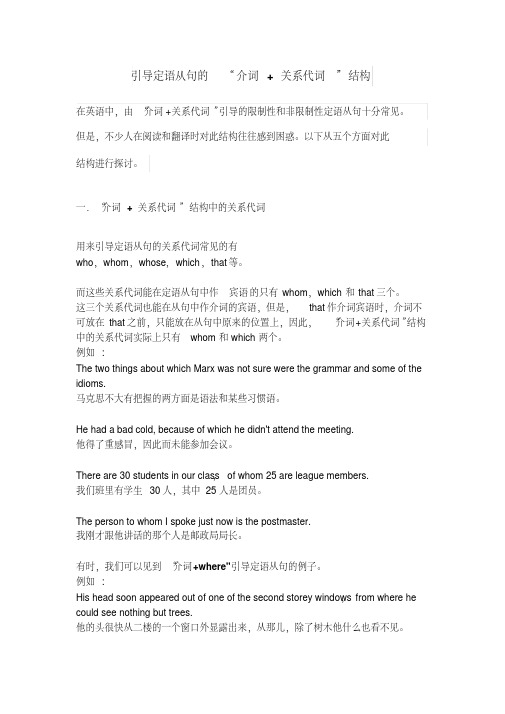
引导定语从句的“ 介词+ 关系代词” 结构在英语中,由“介词+关系代词”引导的限制性和非限制性定语从句十分常见。
但是,不少人在阅读和翻译时对此结构往往感到困惑。
以下从五个方面对此结构进行探讨。
一.“介词+ 关系代词” 结构中的关系代词用来引导定语从句的关系代词常见的有who,whom,whose,which,that等。
而这些关系代词能在定语从句中作宾语的只有whom,which和that三个。
这三个关系代词也能在从句中作介词的宾语,但是,that作介词宾语时,介词不可放在that之前,只能放在从句中原来的位置上,因此,“介词+关系代词”结构中的关系代词实际上只有whom和which两个。
例如:The two things about which Marx was not sure were the grammar and some of the idioms.马克思不大有把握的两方面是语法和某些习惯语。
He had a bad cold, because of which he didn't attend the meeting.他得了重感冒,因此而未能参加会议。
There are 30 students in our class,of whom 25 are league members.我们班里有学生30人,其中25人是团员。
The person to whom I spoke just now is the postmaster.我刚才跟他讲话的那个人是邮政局局长。
有时,我们可以见到“介词+where"引导定语从句的例子。
例如:,from where he His head soon appeared out of one of the second storey windowscould see nothing but trees.他的头很快从二楼的一个窗口外显露出来,从那儿,除了树木他什么也看不见。
介词关系代词课件

• 介词的基本概念 • 关系代词的基本概念 • 介词与关系代词的区别与联系 • 介词关系代词的常见错误分析 • 介词关系代词的练习与巩固
contents
01
介词的定义 01 02
介词的分类
按意义分类
按结构分类
介词的用法
在使用介词时需要注意其搭配和习惯 用法,避免出现语法错误和表达不自 然的情况。
01
02
选择题练习一
选择题练习二
03 选择题练习三
填空题练习
填空题练习一
I saw a thief stealing something from a shop, but I didn't call the police because I didn't want to get involved. (
介词是用来表示名词或代词与句子其 他部分之间关系的词,而关系代词是 引导定语从句的词,用于指代先行词 并在从句中充当成分。
功能
位置
介词通常出现在名词或代词之前,而 关系代词通常出现在引导定语从句的 that、which、who等之后。
介词主要表示时间、地点、方式等关 系,而关系代词主要在定语从句中替 代先行词,引导定语从句。
04
混淆介词与关系代词
总结词
详细描述
介词关系代词的冗余使用
总结词
冗余使用介词关系代词会导致句子冗长、啰嗦,降低语言表达能力。
详细描述
在句子中,介词和关系代词的使用应当是必要的、准确的。如果一个句子中使用了不必要的介词或关系代词,或 者一个介词或关系代词可以省略,那么就会造成冗余。冗余的使用不仅增加了句子的复杂度,还可能引起读者的 困惑。因此,在写作中应避免冗余使用介词关系代词,力求简洁明了。
介词+关系代词
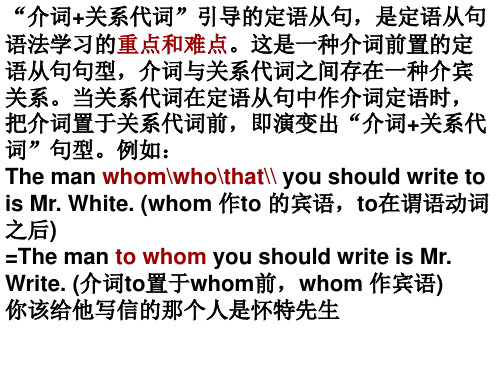
一、当先行词指人时,用“介词+whom”句型 当先行词指人时, 介词 ” 注意:此时不用who或that。 注意:此时不用 或 。 (1)The person to whom I lent my bicycle is Mr. Ball. (whom不能省略,也不用who 或that) 不能省略,也不用 ) 不能省略 (2)The girl with whom my sister visited the Great Wall has just come back from London.
关系代词” “介词+关系代词”引导的定语从句,是定语从句 介词 关系代词 引导的定语从句, 语法学习的重点和难点 重点和难点。 语法学习的重点和难点。这是一种介词前置的定 语从句句型, 语从句句型,介词与关系代词之间存在一种介宾 关系。当关系代词在定语从句中作介词定语时, 关系。当关系代词在定语从句中作介词定语时, 把介词置于关系代词前,即演变出“介词+关系代 把介词置于关系代词前,即演变出“介词 关系代 句型。例如: 词”句型。例如: The man whom\who\that\\ you should write to is Mr. White. (whom 作to 的宾语,to在谓语动词 的宾语, 在谓语动词 之后) 之后 =The man to whom you should write is Mr. Write. (介词 置于 介词to置于 作宾语) 介词 置于whom前,whom 作宾语 前 你该给他写信的那个人是怀特先生
2.根据定语从句中谓语动词与介词的搭配习惯确定 根据定语从句中谓语动词与介词的搭配习惯确定 根据定语从句中 介词。动词不同,要求与之搭配的介词不同, 介词。动词不同,要求与之搭配的介词不同,动 词与不同介词的搭配所表达的意义也大相径庭。 词与不同介词的搭配所表达的意义也大相径庭。 例如: 例如: (1)He lost the book in which he kept many telephone numbers. (2)I don’t know the ’ person to whom you talked just now. 3.根据“介词 关系代词”结构在定语从句中的作 根据“ 关系代词” 根据 介词+关系代词 结构在定语从句中的作 用与含义而确定介词 例如: 而确定介词。 用与含义而确定介词。例如: (1)The plane by which my father went to Shanghai was late. (2)The plane on which my father worked was very large. (此处 which=on the plane表地点 此处on 表地点) 此处 表地点
介词加关系代词(定从)

heavy
目的介词加关系代词(定从)的例句分析
总结词
表示动作发生的意图或 目的
例句
He studied hard in order to get a good grade. (他努力学习是 为了取得好成绩。)
解释
in order to引导定语从 句,修饰a good grade, 表示“为了取得好成 绩”。
作用
介词加关系代词(定从)在句子中起到 修饰名词或代词的作用,限定先行词 的范围或补充说明先行词的属性。
通过使用介词加关系代词(定从),可以 使句子结构更加紧凑,提高语言表达的 效率。
注意事项
在使用介词加关系代词(定从)时,需要注意介词的选择和使用,确保介词与先行词和 从句中的其他成分相符合。
介词的位置可以放在关系代词之前或之后,但需要注意语意和语法上的正确性。
总结词
表示动作发生的地点
例句
The plane flew above the clouds. (飞机飞越云层。)
解释
above引导定语从句,修饰the clouds,表示“飞越云层”。
方式介词加关系代词(定从)的例句分析
1 2
总结词
表示动作发生的方式
例句
He did it in the same way as his teacher. (他 按照老师的方式做了这件事。)
地点介词加关系代词(定从)的用法
总结词
表示地点或位置
详细描述
地点介词如"in", "at", "on"等可以与关系代词(如"which", "where"等)一起使 用,来限定某个地点或位置。例如,"The school at which he teaches is very famous."(他任教的学校非常有名)。
介词+关系代词
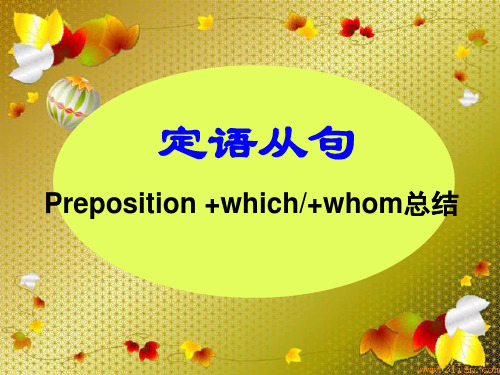
I have lots of friends, some/none of whom _____are friendly.
I have lots of friends, and some of them ____are friendly. I have lots of friends. Some of them ____are friendly.
over/across which _____________a bridge was built.
along which often have a walk. __________we
Point 3 “介词+关系代词”定语从句四大考点 1、恰当的简单介词+关系代词
We managed to find a boat,_______we could in which get to the island. The lab,________the experiments used to be in which done,is being repaired. She is a girl with _________you can share your whom sorrow and happiness.
定语从句
Preposition +which/+whom总结
介词+关系代词
“介词+关系代词”引导定语从句时, 介词的宾语只能用which(指物)或 whom(指人),whose既可指人也可 指物,即介词+which/whom/whose.
介词+关系代词
1. 介词+关系代词与when、 where或why转换 2. 介词的选用 3. “介词+关系代词”型定语 从句四大考点
“介词 + 关系代词”引导的定语从句
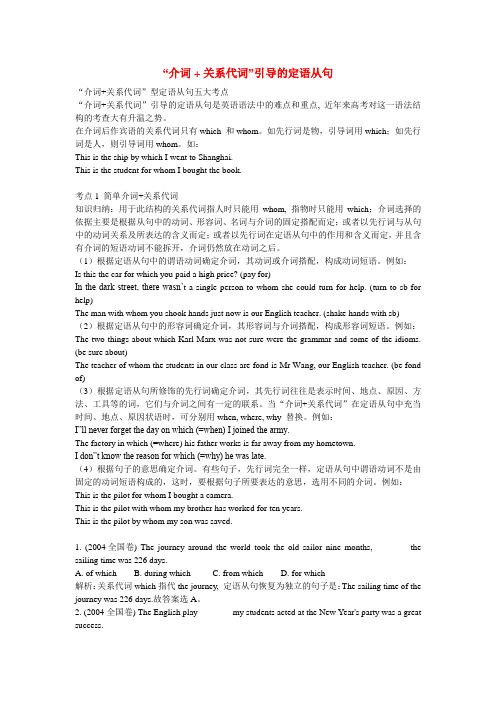
“介词 + 关系代词”引导的定语从句“介词+关系代词”型定语从句五大考点“介词+关系代词”引导的定语从句是英语语法中的难点和重点, 近年来高考对这一语法结构的考查大有升温之势。
在介词后作宾语的关系代词只有which 和whom。
如先行词是物,引导词用which;如先行词是人,则引导词用whom。
如:This is the ship by which I went to Shanghai.This is the student for whom I bought the book.考点1 简单介词+关系代词知识归纳:用于此结构的关系代词指人时只能用whom, 指物时只能用which;介词选择的依据主要是根据从句中的动词、形容词、名词与介词的固定搭配而定;或者以先行词与从句中的动词关系及所表达的含义而定;或者以先行词在定语从句中的作用和含义而定,并且含有介词的短语动词不能拆开,介词仍然放在动词之后。
(1)根据定语从句中的谓语动词确定介词,其动词或介词搭配,构成动词短语。
例如:Is this the car for which you paid a high price? (pay for)In the dark street, there wasn’t a single person to whom she could turn for help. (turn to sb for help)The man with whom you shook hands just now is our English teacher. (shake hands with sb) (2)根据定语从句中的形容词确定介词,其形容词与介词搭配,构成形容词短语。
例如:The two things about which Karl Marx was not sure were the grammar and some of the idioms. (be sure about)The teacher of whom the students in our class are fond is Mr Wang, our English teacher. (be fond of)(3)根据定语从句所修饰的先行词确定介词,其先行词往往是表示时间、地点、原因、方法、工具等的词,它们与介词之间有一定的联系。
介词+关系代词讲义
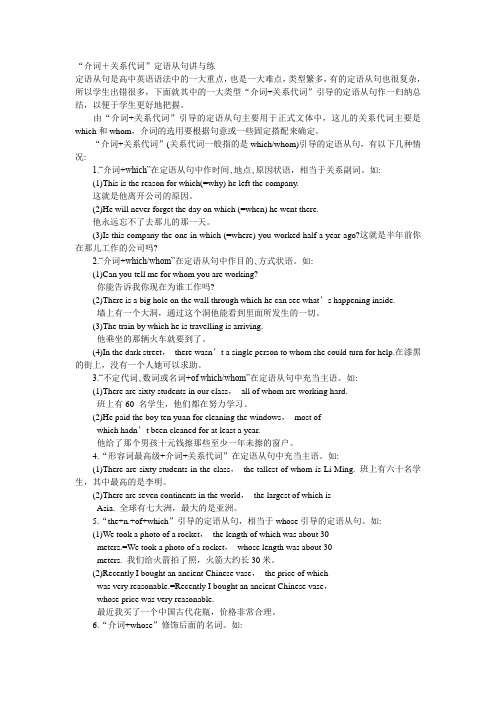
“介词+关系代词”定语从句讲与练定语从句是高中英语语法中的一大重点,也是一大难点,类型繁多,有的定语从句也很复杂,所以学生出错很多,下面就其中的一大类型“介词+关系代词”引导的定语从句作一归纳总结,以便于学生更好地把握。
由“介词+关系代词”引导的定语从句主要用于正式文体中,这儿的关系代词主要是which和whom,介词的选用要根据句意或一些固定搭配来确定。
“介词+关系代词”(关系代词一般指的是which/whom)引导的定语从句,有以下几种情况:1.“介词+which”在定语从句中作时间、地点、原因状语,相当于关系副词。
如:(1)This is the reason for which(=why) he left the company.这就是他离开公司的原因。
(2)He will never forget the day on which (=when) he went there.他永远忘不了去那儿的那一天。
(3)Is this company the one in which (=where) you worked half a year ago?这就是半年前你在那儿工作的公司吗?2.“介词+which/whom”在定语从句中作目的、方式状语。
如:(1)Can you tell me for whom you are working?你能告诉我你现在为谁工作吗?(2)There is a big hole on the wall through which he can see what’s happening inside.墙上有一个大洞,通过这个洞他能看到里面所发生的一切。
(3)The train by which he is travelling is arriving.他乘坐的那辆火车就要到了。
(4)In the dark street,there wasn’t a single person to whom she could turn for help.在漆黑的街上,没有一个人她可以求助。
“介词+关系代词”引导的定语从句

“介词+关系代词”引导的定语从句“介词+关系代词”引导的定语从句中,关系代词只有:Which(指物),whom (指人)。
具体地说,它可以分为5种情况。
其中介词的选择是个难点。
现就各类介词的选择作一总结。
1.介词+which/whom其中,介词的选择主要依据习惯搭配而决定。
即介词与定语从句中谓语动词的搭配、介词与从句中的形容词的搭配、介词与先行词之间的习惯搭配。
:如:The person to whom I spoke just now is my teacher.(speak to…与……谈话)China is a beautiful country,of which we are greatly proud.(be proud of…对……感到自豪)The farm on which I once worked has taken on a new look.(on which=on the farm)有时介词的选择要根据所要表达的意思而定。
如:This is the man with whom he talked just now.这就是刚才与他谈话的人。
This is the man about whom he talked just now.这就是刚才他谈论的人。
注:当先行词是表示时间、地点和原因的名词时,该结构可以分别用关系副词when,where和why替换。
如:I’ll never forget the day on which (=when) I first met him.This is the hotel at which (=where) we stayed last year.The reason for which (=why) he was late for the meeting was very clear. [典型考例]⑴.Is this the house_______ Shakespeare was born? (88全国)A. at whereB. whichC. in whichD. at which解析:答案C. Shakespeare was born in the house.⑵.In the dark street there wasn't a single person_____ she could turn for help.(MET92)A. thatB. whoC. from whomD. to whom解析:答案为 D 。
介词 关系代词知识点总结

介词关系代词知识点总结一、介词1. 介词的定义介词是一种用来引导名词、代词或动名词短语作状语的虚词。
介词通常位于名词、代词或动名词之前,起到连接词和词组,表达时间、地点、方向、原因、条件等关系的作用。
2. 介词的种类介词根据它们的用法和功能可以分为时间介词、地点介词、方向介词、方式介词、原因介词、目的介词等多种类型。
常见的介词包括 at, in, on, by, after, before, under, over, between, among, through, to, from, for, with, without, of, about, etc.3. 介词短语介词短语是由一个介词和它后面的宾语构成的短语结构。
介词短语在句子中可以作状语、定语或补语。
例如:in the classroom(在教室里)、on the table(在桌子上)、by the river(在河边)、for example(例如)、with a pen(用钢笔)等。
4. 介词的用法介词通常用来表示时间、地点、原因、目的、方式等关系。
例如:at 8 o’clock(在8点钟)、in the park(在公园里)、for this reason(因为这个原因)、with great care(以非常小心)、to learn English(为了学习英语)。
5. 介词的搭配介词通常和动词、名词、形容词等搭配使用,不同的介词和不同的词汇搭配会表达不同的含义。
例如:agree to(同意)、arrive at(到达)、interested in(对……感兴趣)、afraid of(害怕)等。
6. 介词的错误用法介词在英语中有一些固定的搭配和用法,如果使用不当可能会导致语法错误。
例如:错误用法为 "apply for the job",正确用法为 "apply to the job"。
7. 介词的考点在英语考试中,介词是一个重要的语法考点,考生需要熟练掌握介词的用法和搭配,避免在考试中出现错误。
“介词+关系代词”考点归纳

“介词 + 关系代词”考点归纳余明朝陕西省商南县高级中学定语从句是高中英语重点语法项目之一, 也是高考必考项目之一。
纵观近几年的高考,不难发现“介词+关系代词”引导的定语从句是考查的热点。
下面就该结构引导的定语从句作一归纳总结,以便于考生更好地把握。
一、考点归纳:1. 用于这种结构的关系代词一般为which(指物)或whom(指人), 有时也用whose (指人或物)。
注意:介词后面不能跟关系代词that或who。
如:He will pay a visit to the house in which he was born twenty years ago.他要去参观20年前他出生的那座房子。
The gentleman about whom you told me yesterday proved to be a thief.你昨天跟我讲的那位先生没想到是小偷。
We entered the room, from whose window we could see the tower clearly.我们进了房间,从窗户处能清楚地看到宝塔。
2. 选用“介词+ 关系代词”结构中的介词时,要根据不同的语境、词组搭配、习语、惯用法等来决定,归纳起来介词的选择主要依据如下几点:①介词与定语从句的先行词是一种习惯性搭配。
如:The farm on which I once worked has taken on a new look.(on the farm)In his room, we saw a big table on which there were all kinds of books.(on the table)Yesterday we had a meeting at which we discussed many problems. (at the meeting)②介词与从句中动词是一种习惯性搭配。
- 1、下载文档前请自行甄别文档内容的完整性,平台不提供额外的编辑、内容补充、找答案等附加服务。
- 2、"仅部分预览"的文档,不可在线预览部分如存在完整性等问题,可反馈申请退款(可完整预览的文档不适用该条件!)。
- 3、如文档侵犯您的权益,请联系客服反馈,我们会尽快为您处理(人工客服工作时间:9:00-18:30)。
“介词+ which / whom”引导的定语从句“介词+关系代词”引导的定语从句,介词与关系代词之间存在一种介宾关系。
当关系代词在定语从句中作介词宾语时,把介词置于关系代词前,即演变出“介词+关系代词”句型。
例如:The man who/whom /that you spoke to is a teacher.=The man to whom you spoke is a teacher.一、基本构成1.“介词+关系代词”结构引导的定语从句中,关系代词只能用which(指物)或whom(指人) ,即:介词+which/whom。
(1)The man to whom you spoke is a teacher.(2)The city in which she lives is far away.(3)The little girl is reading a book,in which there are many cartoons.注意:当介词放在关系代词的前面时,用在介词后的关系代词不能省略。
注:通常介词放在定语从句中动词后,也可以放在关系代词前面,但有些特殊动词短语搭配不能拆分,介词只能放在动词后,如:look for, look after, pay attention to ,take care of , look forward to, listen to等。
This is the pen that / which you are looking for.The patient whom she is looking after is her father.The words that /which we should pay attention to are written on the blackboard. There are fifty patients who/whom/that we must take good care of.二、关系副词when,where,why可用“介词+which”来代替。
关系副词实际上是介词+先行词。
其中when=表时间的介词(如:in,at,during等)+which;Where=表地点的介词(如:in,at,on,under等)+which;Why=表原因的介词(如:for)+whichI still remember the day when I came here. ( on the day =when)This is the house where I lived last year. ( in the house= where)There are many reasons why people like traveling. (for the reasons =why)三、关系代词前介词选择三原则:一先,二动,三意义(重中之重)1.一先,即根据定语从句中介词与先行词的搭配关系选择。
I never forget the day on which I came to this school. (on the day)2.二动,即根据定语从句中谓语动词与介词的搭配关系选择。
This is the iPad on which I spent 3000 yuan. (spend money on sth.)3.三意义,即根据定语从句的意义来确定介词。
This is my pair of glasses, __without which__I cannot see clearly.例题:用“介词+关系代词”的形式表示1. Do you like the book __________ she learned a lot?2. He paid the boy $10 for washing ten windows, most ______ hadn't been cleaned for at least a year.3. The tower _________ people can have a good view is on the hill.注意:介词+关系代词1)介词后面的关系代词不能省略。
2)that前不能有介词。
3)某些在从句中充当时间,地点或原因状语的"介词+关系词"结构可以同关系副词when,where和why互换。
练习:1. He was educated at a local grammar school, ____ he went on to Cambridge. (05山东卷)A. from whichB. after thatC. after whichD. from this2.She was educated at Beijing University, ________ she went on to have her advanced study abroad. (06陕西卷)A. after thatB. from thatC. from whichD. after which3.Gun control is a subject _________Americans have argued for a long time. (09陕西卷)A. of whichB. with whichC. about whichD. into which4.Wind power is an ancient source of energy ______we may return in the near future. (10山东卷)A. on whichB. by whichC. to whichD. from which5.The settlement is home to nearly 1,000 people ,many of ________left their village homes for a better life in the city.(10浙卷)A.whomB.whichC.themD.whose6.The English play ______ my students acted at the New Year’s party was a great success. (04全国I)A for whichB at whichC in whichD on which7. The journey around the world took the old sailor nine months, _____ the s ailing time was 226 days. (04广西)A. of whichB. during whichC. from whichD. for which8. Many people who had seen the film were afraid to go to the forest when they remembered the scenes ______ people were eaten by the tiger. (05广东卷)A. in whichB. by whichC. whichD. that9. She showed the visitors around the museum, the construction _____had taken more than three years. (11江西卷)A.for whichB. with whichC. of whichD. to which10.The place ____ the bridge is supposed to be built should be ___ the cross-river traffic is the heaviest. (05江苏卷)A. which; whereB. at which; whichC. at which; whereD. which; in which11.Eric received training in the computer for one year,______he found a job in a big company.A.after thatB.after whichC.after itD.after this12.Villagers here depend on the fishing industry,________there won't be much work.A.whereB.thatC.by whichD.without whichst week,only two people came to look at the house,________wanted to buy it.A.none of themB.both of themC.none of whomD.neither of whom14. In the office I never seem to have time until after 5:30 pm__________,many people have gone home.A.whose timeB.thatC.on whichD.by which time15.Whenever I met her, _______was fairly often,she greeted me with a sweet smile.(09山东)A.whoB.whichC.whenD.that16.She brought with her three friends,none of ______I had ever met before. (09海南)A.themB.whoC.whomD.these17.Many children, _________parents are away working in big cities,are taken good care of in the village. (09安徽)A.theirB.whoseC.of themD.with whom18.I was born in New Orleans, Louisiana, a city ________name will create a picture of beautiful trees and green grass in our mind.(09湖南)A.WhichB.of whichC.thatD.whose。
